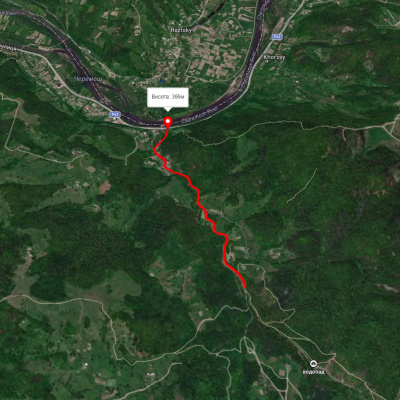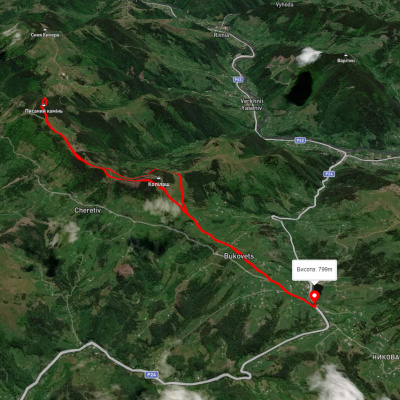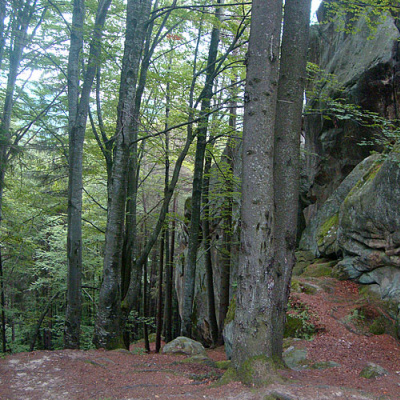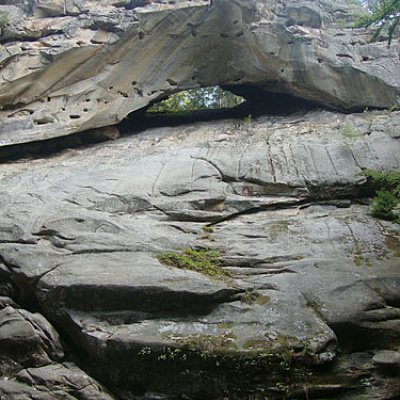The village of Vyzhenka is one of the main tourist settlements of the Vyzhnytsia district and a center of green tourism in Bukovyna. Population (according to the last census): 1380 people. Distance to the city of Chernivtsi: 80 km. The community is proud of the Burkut spring - sulfate-iron-aluminum water.
It has been known since the XVIII century as Verkhnia Vyzhnytsia. The village is on the way to the Nimchych (Turkish Vershad) Pass (586.3 m).
From 1859 until the First World War Vyzhenka was an Austro-Hungarian resort. Around 1860, after the division of the family's inheritance, Mieczysław Rey became the owner of an estate in Vyzhenka (also Vyzhnytsia, Babnia, Chornohuzy, Rivne) in Bukovyna. The pride of the village is the one-domed wooden church of Ivan Suchavskyi (1792) in the Hutsul style, the chapel in honor of the abolition of serfdom in Bukovyna in 1848 (located next to the church of St. Nicholas), St. Nicholas Church (1920s, wooden, covered with tin).
Where the waters of the winding Vyzhenka merge with the turbulent Cheremosh, the village of Vyzhenka, rich in historical monuments, is surrounded by green peaks. Although the village was first mentioned in documents of the 18th century, old people have preserved in their memory an ancient legend that it was here that the Verkhovyna people crossed the path of the wild Tatar hordes. According to the legend, the Tatars moved like a voracious caterpillar, destroying all living things. People had to retreat further and further into the Carpathians. And here, where the Liskivets mountain stream flows into the Vyzhenka, freedom-loving highlanders decided to either repel the enemy or die.
In the meantime, they blocked the passages and passageways with beech and spruce trees, hiding in the forests above the river, waiting for the uninvited guests. They trapped the enemy's advanced units, and then blocked their way to retreat, dug a dam, and the water rushed at the strangers. The Hutsuls killed the Hordes with axes and hooves. Neither bows nor fast steppe horses could save them. The remnants of the frightened horde began to roll back. The current St. John's Church, built in 1792, stands on this site. It was built without a single iron nail.
Above Liskivets, you can go up to the area with the same name, and then swim to the right to the mountain "Berizka". Here you will find a cave formed of huge boulders, called Dovbushova. They say it has a connection to the Galician coast. When the gendarmes were really harassing Dovbush and his comrades, the avengers would get to the cave and always have a safe escape.
Whoever visits Vyzhenka cannot miss another architectural monument, on the stone walls of which are engraved words about the abuse and insults that the serfs had to endure. "Dear brothers! In 1820, the toloks, forests, and all the good things were human: in 1822, the engineers signed them over to the Poles, and the people did not understand. The Ruthenians had to work three days a week as serfs. If they did not come to the land, they were given 50-70 beeches, which made them bleed." And then there is the testimony that in 1866 they survived a famine and cholera."
In the late nineteenth and early twentieth centuries, prominent cultural figures visited Vyzhenka: Yuri Fedkovych, Olena Kobylianska, Lesia Ukrainka, Ivan Franko, Vasyl Stefanyk, and Marko Cheremshyna. In 1902, Opanas Shevchukevych, a famous Ukrainian sculptor, doctor, and writer, was born here.
The poetic beauty of the Prykarpattia region, the availability of high-quality raw materials, and the natural abilities of the craftsmen contributed to the development of folk art in Vyzhenka. Traditional folk crafts include wood carving, woodworking, Easter egg making, and embroidery.
St. Nicholas Church in the village of Vyzhenka, Chernivtsi region, near the town of Vyzhnytsia, was built in 1921-1925 according to the canons of the Hutsul school of folk architecture characteristic of this area and is located in the southern part of the village on a hill, near a steep bend in the road. The church of St. Paraskeva in the village of Ust-Putyla is similar.
Thewooden church of St. Nicholas is cruciform in plan, three-story, with almost identical octagonal tops over all three parts of the building. The nave has large extensions on both sides, crowned with cupolas, which creates the illusion of a five-story Galician church. Today, the church is almost completely covered with tin (except for the lowest part of the log cabins, which is painted green). The church is surrounded by a large free space, so it is good to see it from different sides. Only on the northeastern side, from the road, are there a few trees. On the north and west sides, a cemetery stretches at some distance.
Not far away is a stone bell tower, which is somewhat similar to the bell tower of the neighboring church of St. John of Suceava in the same village. The bell tower is of the wall type and consists of five columns. By the road, near St. Nicholas Church, there is a stone chapel covered with a shingle roof. According to historians, it was built in 1848 in honor of the abolition of serfdom in the Austrian Empire. Numerous inscriptions on the chapel testify to the wanderings of the peasants on the serfdom, to the heavy obligatory duties, illnesses, and all the hardships of the locals that fell to their lot in the nineteenth century. These inscriptions are popular with travelers and travelers, because the village of Vyzhenka is one of the centers of green tourism in Bukovyna.
Today, the Church of St. Nicholas in Vyzhenka is a functioning church, distinguished by its original construction and impressive size, belongs to the diocese of the UOC-MP and is an architectural monument of local importance. Further to the south, the road begins to climb the Nimchych Pass, and there is also a recreational area nearby - the Luzhky tract.
The commemorative chapel on the occasion of the abolition of serfdom in Bukovyna (1848) is located in the village of Vyzhenka, Chernivtsi region, within the fence line of the local church of St. Nicholas the Wonderworker. In 1864-1866, more than 20 thousand people died in Bukovyna from natural disasters, famine, cholera and typhus epidemics in a short time. Tens of thousands of hungry people went in search of bread and salvation to Ukraine and Bessarabia. An unknown chronicler wrote a kind of chronicle about these terrible events on two commemorative plates.
The inscription on the walls is engraved in stone in Church Slavonic and the appropriate font: "Brothers, in the year 1820, the workdays, forests, and all the good things were human. In 1822, engineers recorded the year 1822 for the Poles, but the people did not understand. The Ruthenians had to work 3 days a week as serfs, and if they did not come to work, they were given 50-70 beeches, which made them bleed... In 1866 there was a famine and cholera..." According to the Law of Ukraine, this chapel belongs to the cultural heritage of Ukraine.








